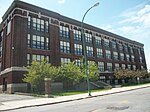Rev. J. Edward Nash Sr. House
African-American history of New York (state)African-American museums in New York (state)Biographical museums in New York (state)Buffalo, New York Registered Historic Place stubsBuffalo, New York building and structure stubs ... and 7 more
Historic house museums in New York (state)Houses in Buffalo, New YorkHouses on the National Register of Historic Places in New York (state)Museums in Buffalo, New YorkNational Register of Historic Places in Buffalo, New YorkNew York (state) museum stubsQueen Anne architecture in New York (state)

Rev. J. Edward Nash Sr. House is a historic home located at Buffalo in Erie County, New York. The house was constructed in 1892 and is in the Queen Anne style. It was home to Rev. J. Edward Nash Sr. (1868–1957), a prominent leader in Buffalo's African American community. He served as pastor at the Michigan Avenue Baptist Church from 1892 to 1953. Rev. Nash purchased the frame, two flat home in 1925 and his wife remained in the home until 1987. The house underwent exterior restoration in 2002-2003 and has been designated the Nash House Museum.It was listed on the National Register of Historic Places in 2007.
Excerpt from the Wikipedia article Rev. J. Edward Nash Sr. House (License: CC BY-SA 3.0, Authors, Images).Rev. J. Edward Nash Sr. House
Arsenal Place, Buffalo
Geographical coordinates (GPS) Address Nearby Places Show on map
Geographical coordinates (GPS)
| Latitude | Longitude |
|---|---|
| N 42.885833333333 ° | E -78.866944444444 ° |
Address
Arsenal Place 22
14204 Buffalo
New York, United States
Open on Google Maps











